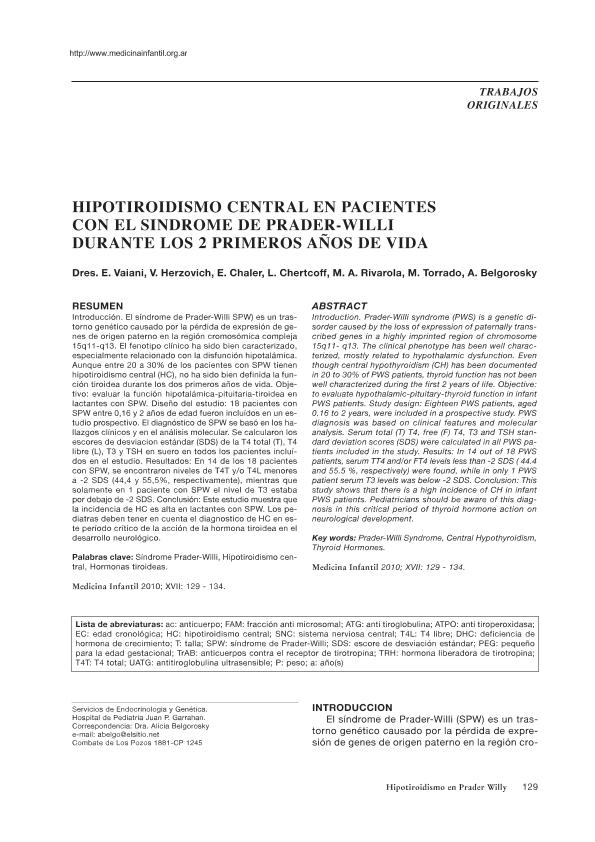Mostrar el registro sencillo del ítem
dc.contributor.author
Vaiani, E.
dc.contributor.author
Herzovich, V.
dc.contributor.author
Chaler, E.
dc.contributor.author
Chertkoff, Lilien Patricia

dc.contributor.author
Rivarola, Marco Aurelio

dc.contributor.author
Torrado, M.
dc.date.available
2023-02-04T02:12:57Z
dc.date.issued
2010-03
dc.identifier.citation
Vaiani, E.; Herzovich, V.; Chaler, E.; Chertkoff, Lilien Patricia; Rivarola, Marco Aurelio; et al.; Hipotiroidismo central en pacientes con el síndrome de Prader-Willi durante los 2 primeros años de vida; Fundación Hospital de Pediatría "Juan P. Garrahan"; Medicina Infantil; 17; 2; 3-2010; 129-134
dc.identifier.issn
0328-0160
dc.identifier.uri
http://hdl.handle.net/11336/186874
dc.description.abstract
Introducción. El síndrome de Prader-Willi SPW) es un trastorno genético causado por la pérdida de expresión de genes de origen paterno en la región cromosómica compleja 15q11-q13. El fenotipo clínico ha sido bien caracterizado, especialmente relacionado con la disfunción hipotalámica. Aunque entre 20 a 30% de los pacientes con SPW tienen hipotiroidismo central (HC), no ha sido bien definida la función tiroidea durante los dos primeros años de vida. Objetivo: evaluar la función hipotalámica-pituitaria-tiroidea en lactantes con SPW. Diseño del estudio: 18 pacientes con SPW entre 0,16 y 2 años de edad fueron incluídos en un estudio prospectivo. El diagnóstico de SPW se basó en los hallazgos clínicos y en el análisis molecular. Se calcularon los escores de desviacion estándar (SDS) de la T4 total (T), T4 libre (L), T3 y TSH en suero en todos los pacientes incluídos en el estudio. Resultados: En 14 de los 18 pacientes con SPW, se encontraron niveles de T4T y/o T4L menores a -2 SDS (44,4 y 55,5%, respectivamente), mientras que solamente en 1 paciente con SPW el nivel de T3 estaba por debajo de -2 SDS. Conclusión: Este estudio muestra que la incidencia de HC es alta en lactantes con SPW. Los pediatras deben tener en cuenta el diagnostico de HC en este período crítico de la acción de la hormona tiroidea en el desarrollo neurológico.
dc.description.abstract
Introduction. Prader-Willi syndrome (PWS) is a genetic disorder caused by the loss of expression of paternally transcribed genes in a highly imprinted region of chromosome 15q11- q13. The clinical phenotype has been well characterized, mostly related to hypothalamic dysfunction. Even though central hypothyroidism (CH) has been documented in 20 to 30% of PWS patients, thyroid function has not been well characterized during the first 2 years of life. Objective: to evaluate hypothalamic-pituitary-thyroid function in infant PWS patients. Study design: Eighteen PWS patients, aged 0.16 to 2 years, were included in a prospective study. PWS diagnosis was based on clinical features and molecular analysis. Serum total (T) T4, free (F) T4, T3 and TSH standard deviation scores (SDS) were calculated in all PWS patients included in the study. Results: In 14 out of 18 PWS patients, serum TT4 and/or FT4 levels less than -2 SDS ( 44.4 and 55.5 %, respectively) were found, while in only 1 PWS patient serum T3 levels was below -2 SDS. Conclusion: This study shows that there is a high incidence of CH in infant PWS patients. Pediatricians should be aware of this diagnosis in this critical period of thyroid hormone action on neurological development.
dc.format
application/pdf
dc.language.iso
spa
dc.publisher
Fundación Hospital de Pediatría "Juan P. Garrahan"
dc.rights
info:eu-repo/semantics/openAccess
dc.rights.uri
https://creativecommons.org/licenses/by-nc-sa/2.5/ar/
dc.subject
HIPOTIROIDISMO
dc.subject
PRADER-WILLI
dc.subject
TRASTORNO
dc.subject
GENETICO
dc.subject.classification
Genética Humana

dc.subject.classification
Medicina Básica

dc.subject.classification
CIENCIAS MÉDICAS Y DE LA SALUD

dc.title
Hipotiroidismo central en pacientes con el síndrome de Prader-Willi durante los 2 primeros años de vida
dc.title
Central hypothyroidism in patients with Prader-Willi syndrome during the first 2 years of life
dc.type
info:eu-repo/semantics/article
dc.type
info:ar-repo/semantics/artículo
dc.type
info:eu-repo/semantics/publishedVersion
dc.date.updated
2023-01-31T17:38:56Z
dc.journal.volume
17
dc.journal.number
2
dc.journal.pagination
129-134
dc.journal.pais
Argentina

dc.journal.ciudad
Ciudad Autónoma de Buenos Aires
dc.description.fil
Fil: Vaiani, E.. Gobierno de la Ciudad de Buenos Aires. Hospital de Pediatría "Juan P. Garrahan"; Argentina
dc.description.fil
Fil: Herzovich, V.. Gobierno de la Ciudad de Buenos Aires. Hospital de Pediatría "Juan P. Garrahan"; Argentina
dc.description.fil
Fil: Chaler, E.. Gobierno de la Ciudad de Buenos Aires. Hospital de Pediatría "Juan P. Garrahan"; Argentina
dc.description.fil
Fil: Chertkoff, Lilien Patricia. Consejo Nacional de Investigaciones Científicas y Técnicas; Argentina. Gobierno de la Ciudad de Buenos Aires. Hospital de Pediatría "Juan P. Garrahan"; Argentina
dc.description.fil
Fil: Rivarola, Marco Aurelio. Consejo Nacional de Investigaciones Científicas y Técnicas; Argentina. Gobierno de la Ciudad de Buenos Aires. Hospital de Pediatría "Juan P. Garrahan"; Argentina
dc.description.fil
Fil: Torrado, M.. Gobierno de la Ciudad de Buenos Aires. Hospital de Pediatría "Juan P. Garrahan"; Argentina
dc.journal.title
Medicina Infantil
dc.relation.alternativeid
info:eu-repo/semantics/altIdentifier/url/https://www.medicinainfantil.org.ar/index.php/ediciones-anteriores/2010-volumen-xvii/numero-2
Archivos asociados
